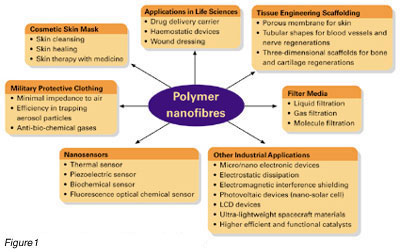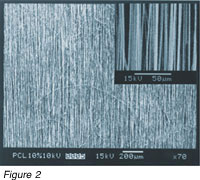|
by Zheng-Ming HUANG, Masaya KOTAKI and Seeram RAMAKRISHNA
 number of amazing characteristics arise when polymer fibre materials shrink in diameter from micrometres to sub-microns or nanometres. Among their important properties, two that stand out are a very large ratio of surface area to volume, and superior mechanical performance (stiffness and tensile strength) compared to any other known fibre-material form. These outstanding properties make polymer nanofibres optimal candidates for important applications such as filtration, biomedicine, protective clothing, electrical and optical use, and nanocomposites. Figure 1 summarises promising applications. number of amazing characteristics arise when polymer fibre materials shrink in diameter from micrometres to sub-microns or nanometres. Among their important properties, two that stand out are a very large ratio of surface area to volume, and superior mechanical performance (stiffness and tensile strength) compared to any other known fibre-material form. These outstanding properties make polymer nanofibres optimal candidates for important applications such as filtration, biomedicine, protective clothing, electrical and optical use, and nanocomposites. Figure 1 summarises promising applications.

Before any of these applications can be made, a fundamental step must be taken - preparation of the polymer nanofibres. For this purpose electrospinning is used, in which polymer fluid (solution or melt) is charged with a high electrical voltage. When the electrical force rises high enough to overcome the surface tension of the polymer fluid, a metal spinneret or needle of 0.1-1mm in diameter ejects a fluid jet towards a grounded metal collector. During this travel, the charged fluid jet undergoes whipping-like bending instability and elongation, resulting in an evaporated or solidified fibre of a very small size. Its diameter ranges from a low of three nanometres to one micrometre. A continuous nanofibre can be fabricated if no shortage in supply of the polymer fluid occurs.
Although electrospinning has appeared in the literature for several decades and has been understood to be the only technique for mass production of continuous polymer nanofibres, scientists' understanding of it is still very limited. Not every polymer can be electrospun into superfine fibres, and the polymer content (concentration) in the solution that yields the fibres must be set to an optimal value. Little knowledge exists on controlling the diameter of the resulting nanofibres, and especially on obtaining uniaxially aligned continuous nanofibres. To address this lack of information, a research programme led by Seeram Ramakrishna has just been initiated at the National University of Singapore to systematically investigate processing, mechanical and biological characterisation, as well as industrial applications of various polymer nanofibres.
For the processing study, the researchers target exploration of the spinability range of polymers and success in obtaining nanofibres with consistent diameters, uni-axially aligned. Among various parameters influencing fibre diameter and consistency, the polymer concentration in its solution, the applied electrical voltage and the solution temperature have all been found to play dominant roles. Efforts are being made in the laboratory to optimise these parameters for specific polymers so that prescribed and consistent fibre diameters will become available.

Most nanofibres obtained so far take essentially a non-woven (randomly arranged) form, which has relatively small application ranges. Only when a continuous single nanofibre is obtained can its application be made unlimited. The team has already achieved relatively well-aligned nanofibres (Figure 2) and continuous polymer nanofibre strand.
The second goal is to investigate the mechanical and biological behaviour of single polymer nanofibres because no such work has been reported in the literature. The mechanical properties of nanofibres will be determined by different methods, including skilful direct testing (using atomic force microscope, laser tweezers and nanoindentor) for some axial properties; indirect testing (i.e. retrieval from the overall responses of unidirectional nanofibre-reinforced composites) for other properties; and theoretical simulations for correlations. The researchers will undertake a biomedical-compatibility study, using both nanofibre mats (membranes) and single nanofibres. Researchers are developing molecular filters and bionanosensors uing polymer nanofibres. Further application of polymer nanofibres lies in the orthodontic and orthopaedic fields such as in arch wires, brackets and bone plates. Nanofibres are supposed to perform better than microfibres mechanically. If researchers can obtain polymer nanofibres with properties comparable to those of micron glass fibres, for instance, they can use them for the development of arch wires and brackets that can be expected to have better mechanical and aesthetic characteristics than existing equipment. Furthermore, using electro-spun biodegradable nanofibres will make possible non-removable implants with significantly better mechanical properties than those ever seen in the literature.
For more information contact Seeram Ramakrishna at etpdir@nus.edu.sg
|


 number of amazing characteristics arise when polymer fibre materials shrink in diameter from micrometres to sub-microns or nanometres. Among their important properties, two that stand out are a very large ratio of surface area to volume, and superior mechanical performance (stiffness and tensile strength) compared to any other known fibre-material form. These outstanding properties make polymer nanofibres optimal candidates for important applications such as filtration, biomedicine, protective clothing, electrical and optical use, and nanocomposites. Figure 1 summarises promising applications.
number of amazing characteristics arise when polymer fibre materials shrink in diameter from micrometres to sub-microns or nanometres. Among their important properties, two that stand out are a very large ratio of surface area to volume, and superior mechanical performance (stiffness and tensile strength) compared to any other known fibre-material form. These outstanding properties make polymer nanofibres optimal candidates for important applications such as filtration, biomedicine, protective clothing, electrical and optical use, and nanocomposites. Figure 1 summarises promising applications.

